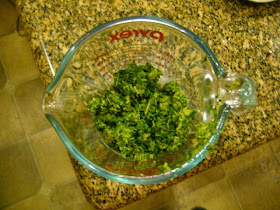 |
| Dana Carvey Performs The Lady I Know |
It is one of my most favorite skits from Saturday Night Live past. Comedian Dana Carvey performs the timeless classic of "The Lady I Know," otherwise known by its second and more popular name: Choppin' Broccoli. That skit -- which he still performs during his live shows -- is guaranteed to bring a bundle of laughs. Even though the song is nothing more than a repeat of the lines: "Choppin' Broccoli."
I guess it's the genius of Dana Carvey. See him perform his timeless classic -- with a full band behind him no less -- here on the Tonight Show with fellow SNL alum Jimmy Fallon.
 |
| Broccoli From the Bird Back 40 |
I'm reminded of this timeless classic every time I pull out a head of broccoli for one of our favorite meals or side dishes. This is broccoli season in California. You can find it for dirt cheap in most grocery stores -- and you can find it growing in the dirt that comprises the Bird Back 40. We're not just growing broccoli, the wife that is Venus and I have been gifted with the greatest of broccoli harvests in Bird Back 40 history. I've never grown broccoli like this before -- even though I've tried before (and failed somewhat miserably I might add).
So what am I doing different this year as compared to past years in the garden? Good question. I'm not really sure. Perhaps we just planted seeds and starter plants at the right time this year. Perhaps waiting until early spring to start our broccoli crops wasn't the best of ideas. Perhaps we should have started our broccoli growing efforts in the early fall -- as we did this year.
 |
| Bird Back 40 Broccoli Patch |
I must admit -- I had my doubts. Although I did "cheat" somewhat this year and purchased a six pack of broccoli plant starters from Emigh's ACE Hardware in Carmichael -- Venus also scattered broccoli seed over a wide swath in one of the 4X8 gardening beds. The end result is we have about 10-15 broccoli plants that are sporting the best looking heads of broccoli I've ever seen. There's no bug damage on the crowns either -- which is another big plus.
The first doubts surfaced just after planting our starter plants in early October. Those small plants were immediately attacked by an invading horde of ravenously hungry slugs and snails. Spreading out some pet-safe slug and snail bait helped minimize the damage somewhat, but it wasn't totally foolproof. The leaves on the broccoli plants are peppered with slug and snail damaged holes. But those broccoli crowns -- that tasty meal we yearn for -- haven't been touched.
 |
| Freshly Harvested From the Bird Back 40 |
Why? I have no idea. I do not profess to be a Zen-Garden master. I only plant, irrigate, spread out some slug bait and wait. Whatever happens -- happens. I might also add that the gardening cat known as Lenny -- the wife's ultra spoiled Maine Coon furball of a cat -- also loved digging up those starter plants at the first opportunity. And you thought gardening was easy? Perish the thought. Between the slugs, snails and Lenny's incessant garden attacks, it's a wonder that any of the starter plants or plants grown from seed survived.
Broccoli was one of the first vegetables that I actually consumed as a child. Mom didn't grow it. She didn't buy it fresh either. Nope -- our broccoli in 1970's Modesto came from the blocks of frozen broccoli chunks that are still sold in stores today. That was an easy vegetable fix for a single mother of four children who had been forced into the world of full-time employment. At first -- as I recall -- I wouldn't touch the stuff. However -- when mother resorted to sprinkling this broccoli with processed lemon juice -- well, it was heaven at first bite. I couldn't get enough.
 |
| A New Wok for Christmas |
It's been a long journey -- from frozen blocks of broccoli chunks to freshly grown broccoli from the backyard. I'll still douse the end result with lemon in some cases -- but I'm also partial to an herbed broccoli recipe that I stumbled across one day in one of the original Betty Crocker cookbooks (this is before Betty sold out to commercial interests). Broccoli Beef -- which we made just the other night from scratch using freshly harvested broccoli heads and grass-fed beef (flank steak) from Chaffin Family Orchards north of Oroville -- was a gastrointestinal delight to be sure.
Short and sweet? There are one million and one uses for broccoli. And given that we appear to have an unlimited supply in the Bird Back 40 (I am a tad concerned about how freezing temperatures will affect these plants) -- the end result will hopefully be a winter full of meals featuring freshly grown broccoli and other greens.
Which means I'll be chopping a lot of broccoli to the tune of "The Lady I Know."
Recipe for Herbed Broccoli:
Author's note: We always double, triple or even quadruple the amount of garlic in this recipe because, well, you can never get enough garlic in my humble opinion! We also double up on the spices.
1 lb. steamed broccoli
2 tablespoons olive oil
1 teaspoon dried basil leaves
1 teaspoon dried oregano leaves
1 teaspoon dried marjoram leaves
1/2 teaspoon salt (do not double)
2 cloves of garlic, crushed
2 Roma type tomatoes, chopped
Directions: Mix oil, herbs, salt, garlic and chopped tomatoes and set aside. Steam fresh broccoli on high heat for four minutes and remove to a serving dish immediately. Add tomato-herb mixture, mix well and enjoy!









































